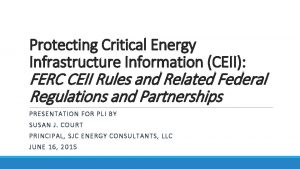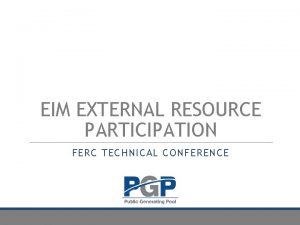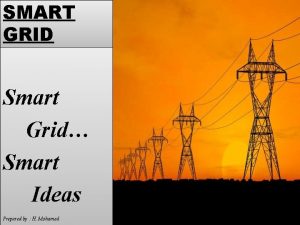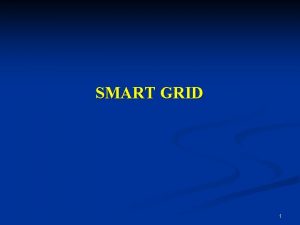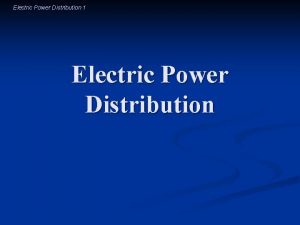Smart Grid Electric Power Industry and the FERC






- Slides: 6

Smart Grid: Electric Power Industry and the FERC Kevin Kelly Director, Policy Development Division Office of Energy Market Regulation Federal Energy Regulatory Commission EBA Smart Grid Primer for Lawyers Washington, DC December 4, 2009 The author’s views do not necessarily represent the views of the Federal Energy Regulatory Commission.

TOPICS 1. Government Interest in a Smart Grid 2. EISA’s Title XIII: Smart Grid 3. FERC’s Smart Grid Policy Statement 4. Developing the Smart Grid Standards 2

1. Government Interest in a Smart Grid n n Governments are interested in the smart grid along with industries, manufacturers, consumers, and the press. President Obama has energized several industries to develop/deploy smart grid technologies—and government agencies to develop a smart grid framework—quickly. n Recovery Act reinforces the interest and urgency: provided stimulus dollars for a smart grid—as covered in a later panel. n State governments are also interested, especially because the smart grid enables load management and demand response. 3

2. EISA’s Title XIII: Smart Grid n EISA is the Energy Independence and Security Act of 2007 n n n EISA assigns NIST (National Institute of Standards and Technology) to coordinate the development of an interoperability framework for a smart grid n n working through many standards development organizations (SDOs). EISA assigns FERC to “adopt” these standards by rulemaking n n declares the policy of the U. S. is to support a smart grid assigns various smart grid research, studies and activities to DOE when FERC finds there is sufficient consensus on a standard. FERC already has processes for approving standards: NERC, NAESB. FERC is working closely with NIST to coordinate our efforts. EISA establishes new PURPA title I standards for states to consider. n n Rate treatment of smart grid investments Access to smart grid information such as prices and customer usage 4

3. FERC’s Smart Grid Policy Statement n The Commission adopted six smart grid priority areas: n n n n System Security Communication/Coordination Across Inter-System Interfaces Wide-Area Situational Awareness Demand Response Electric Storage Electric Vehicles The Commission expects to work with the states on these topics through the NARUC-FERC Smart Grid Collaborative. The Commission also adopted an interim rate policy to encourage early investment in smart grid systems: n Allow recovery of jurisdictional smart grid investments that: n n n advance the goals of EISA section 1301 don’t adversely affect reliability and cyber-security minimize the possibility of stranded costs share the results with DOE’s Smart Grid Clearinghouse Interim rate policy is in effect until interoperability standards are adopted. 5

4. Developing Smart Grid Standards for the Electric Power Industry n Standards are important to the electric power industry. n Standards will affect a huge segment of the economy and bring large gains and costs to electricity consumers. n The companies you represent should help shape these standards. n Urge them to be involved in the NIST/SDO process. n Don’t hold back, hoping to litigate technical standards at FERC. n Get involved now: some standards will be developed quickly. n Cooperation of several diverse industries is hard but crucial. 6
